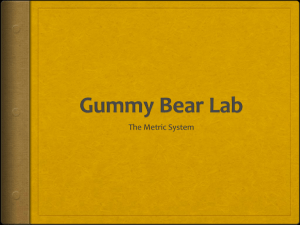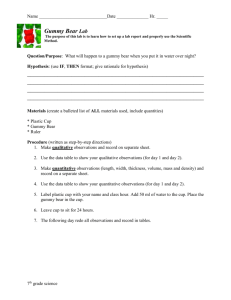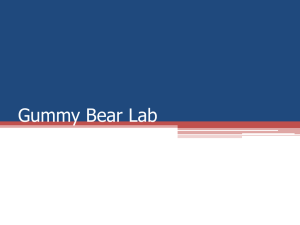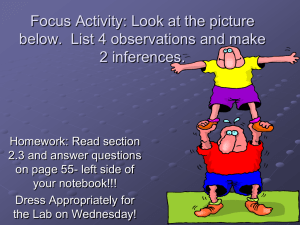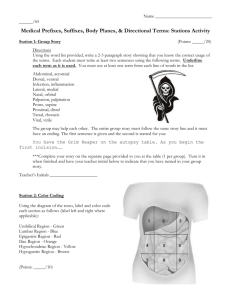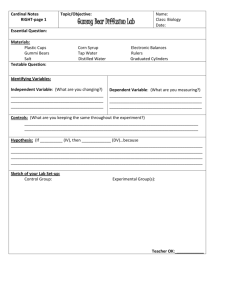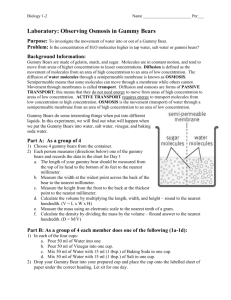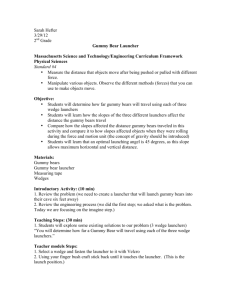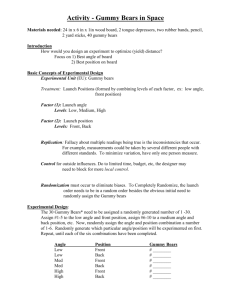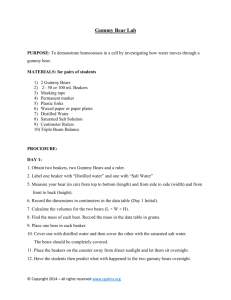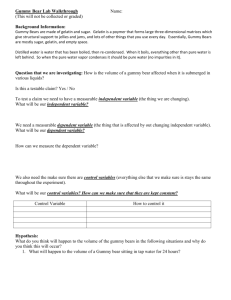Gummy Bear Density Lab: Science Experiment Worksheet
advertisement
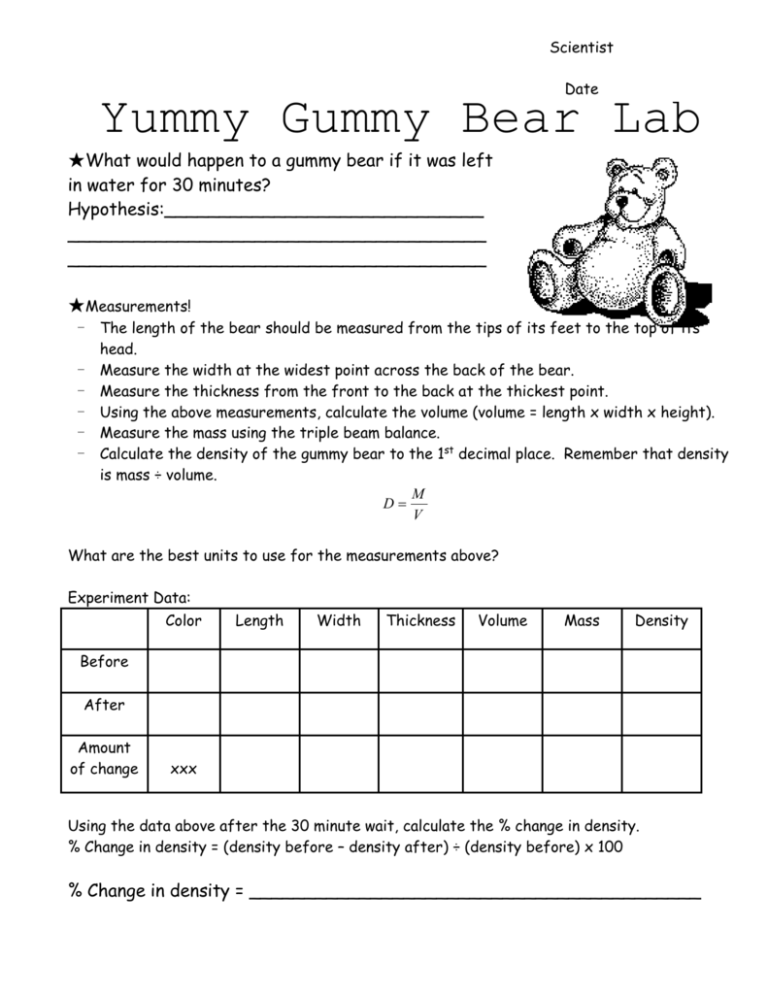
Scientist Date Yummy Gummy Bear Lab ★What would happen to a gummy bear if it was left in water for 30 minutes? Hypothesis:_____________________________ ______________________________________ ______________________________________ ★Measurements! - The length of the bear should be measured from the tips of its feet to the top of its head. Measure the width at the widest point across the back of the bear. Measure the thickness from the front to the back at the thickest point. Using the above measurements, calculate the volume (volume = length x width x height). Measure the mass using the triple beam balance. Calculate the density of the gummy bear to the 1st decimal place. Remember that density is mass ÷ volume. M D V What are the best units to use for the measurements above? Experiment Data: Color Length Width Thickness Volume Mass Density Before After Amount of change xxx Using the data above after the 30 minute wait, calculate the % change in density. % Change in density = (density before – density after) ÷ (density before) x 100 % Change in density = _________________________________________ ★Experiment Two★ Using the previous experiment, change a variable and predict the outcome. Hypothesis: ___________________________________________________ Experiment Data: Color Before After Amount of change Other observations: Length Width Thickness Volume Mass Density ★ irregular Objects★ Find the density of irregular objects. In order to find the density, we will have to find the mass and the volume of the object. The mass will be easy to measure using a triple beam balance. ★How would we find the volume? ___________________________________ ____________________________________________________________ ____________________________________________________________ Object Estimated Volume (mL) Beginning Water Level (mL) Ending Water Level (mL) Difference in Water Levels (mL) Volume of Objects (mL) ★ Now, find the mass of the object and using the volume found above, calculate the density. Object Mass (g) Volume (mL) Density (g/mL) mystery graph★ ★ ★ Create a story to explain the graph below. Yummy Gummy Bear Lab Objective: Learn to measure volume and mass using appropriate methods and units to calculate an objects density. Anticipatory Set: Use bowling balls to show how different densities can affect things. The students all think that a bowling ball will sink straight to the bottom of a container filled with water. This however, is not true for an 8 lb bowling ball. It will float. Use an 8 lb ball and one that is greater than 12 lbs. Materials Needed: - Gummy bears (one per student + some to eat) - Metric Rulers - Triple beam balances - Distilled Water - Calculators - Plastic cups - Graduated cylinders - Small objects (such as marbles, jacks, nuts and bolts…) Standards: Math Standards: NO 1.6.1 – Demonstrate conceptual understanding to find a specific percent of a number using models, real life examples or explanations. M 13.6.3 – Draw and measure distances to the nearest millimeter. DAP 16.6.1 – Use observations about differences in data to make justifiable inferences. M 12.6.1 - Identify and select appropriate units and tools to measure. M13.6.6 - Use estimation to check reasonableness of measurements obtained from use of various instruments. Science Standards: NS 1.6.1 – Verify accuracy of observations. NS 1.6.2 – Apply components of experimental design used to produce empirical evidence. NS 1.6.4 – Construct and interpret scientific data using data tables/charts. NS 1.6.5 - Communicate results and conclusions from scientific inquiry. PS 5.6.4 - Apply skills of scientific investigation to determine density using SI units. PS 6.6.6 – Compare and contrast weight and mass. Procedure: 1. Ask students about density and if they know what it is. Discuss the topic and go over the formula for density. Ask what is needed in order to calculate density. 2. Go over handout and discuss appropriate units that can be used for the measurements that students have to make. Discuss accuracy in those measurements. 3. Let students take the measurements, record the data, and use measurements to calculate the density of their gummy bear. 4. Drop the gummy bear in 50 mL distilled water and set aside for 30 minutes. 5. Read Mr. Archimedes’ Bath (by Pamela Allen) and talk about water displacement. 6. Discuss the accuracy of the volume measurements for the gummy bears. Give the students a few irregular objects, along with a ruler, graduated cylinder, beaker and compass, and ask them to find the volume. 7. After a few minutes, discuss the most appropriate way to find the volume of the irregular objects, remind them about the story Mr. Archimedes’ Bath. 8. Let students find the volume and mass of the irregular objects and calculate the density. 9. After 30 minutes, take gummy bears out of the water, dry them off with a paper towel, and measure the volume and the mass and then calculate the density. Did the density change? Why or why not? Extensions: Experiment Two: As an extension of the previous experiment, have students change a variable and conduct the experiment again. Variables can include different temperatures of water, sugar water, salt water, or different types of candy. Talk about the importance of variables and controls and only varying one variable at a time. Writing Extension: Give students the mystery graph and have them come up with a story to describe what they see. One possible story could be about someone taking a bath. Have the x-axis represent time, while the y-axis represent water level. The water gets turned on and increases as the tub fills up. The water levels off when the water is turned off, then slightly increases as someone steps into the tub to test out the water. The water level flattens out while the person gets used to the temperature of the water, and then the water level increases as the person sits down. The water level will decrease then level when the person stands up and grabs a towel to dry off with. As the person steps out of the tub, the water level will decrease slightly and then level off again. The water will steadily decrease after the plug is pulled and the tub starts to drain. Reading Extension: Mr. Archimedes’ Bath – Pamela Allen. Higher Level Math Extension: Have students find the circumference of the bowling ball and then calculate the volume. Find the mass and measure the density of the bowling balls, compare that to the density of water (1 g/mL). Other Notes: It was found that the gummy bears expand at times and shrink at others, so be ready for both. The kind that has been recommended by others, and ended up expanding in the end is Brachs Gummy Bears.
